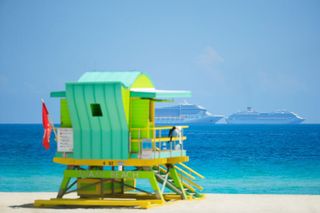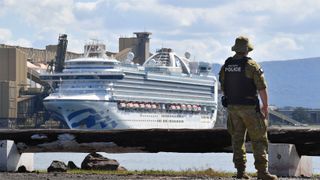Can you put a price on fear? Cruise lines will soon be the first industry to find out for real. After more than 1,000 confirmed cases of novel coronavirus (COVID-19) onboard either ocean or river cruise ships, the industry is on hold. Worse still, tens of thousands of passengers were stranded for weeks as most of the world’s ports refused disembarkation. Now comes multiple lawsuits and a criminal investigation in Australia as to whether the industry was honest about the extent of the virus’s spread. Can an industry recover from such reputational damage? The cruise industry has deep pockets and has perfected yield management over more than four decades, but we do not know how bad it will get. What will a recovery plan need to take into account?
The cruise industry has deep pockets and has perfected yield management over more than four decades, but we do not know how bad it will get. What will a recovery plan need to take into account?
On 4 February 2020, the Diamond Princess was allowed to dock in Yokohama, Japan. The ship was quarantined due to seven suspected cases of COVID-19 on board. This eventually ballooned to 700 people infected and eight deaths. This incident first alerted health authorities to the substantial spread of the virus amongst passengers and crew. The Diamond Princess was followed by the World Dream, the Westerdam and then a steady stream of cruise ships with confirmed COVID-19 infections. More ships were then suspected, leading port authorities around the world to close their docks to foreign ships.
Peak cruise season has passed in Australia, where the month of January sees around 40 ship turnarounds in Sydney Harbour. However in Florida, the centre of US cruise shipping, the industry was gearing up for a now-cancelled spring peak period. Between Port Everglades in Fort Lauderdale and the Port of Miami, Florida handles more than 70 per cent of US cruising.
Yet in mid-March, four ships returned to US ports and offloaded passengers with no change-over guests embarking. The Cunard Queen Victoria, the Island Princess, the Celebrity Reflection and the Serenade of the Seas disgorged some of the last cruise passengers onto US soil for a long while. Two further ships from Holland America Lines also docked at Port Everglades, after being initially refused entry to several Caribbean countries. The cruise line, owned by Carnival Corporation, has described the Florida port as its "port of last resort.”

However, further Carnival ships have been denied access, due to having no plan in place to deal with the COVID-19 infected passengers on board.1 Previously US President Donald Trump urged Florida Governor Ron DeSantis to bar cruise ships from docking. Many cruise ships now sail around the world empty, but with no obvious port to call home. The remaining crew could be left in a legal limbo that has also played out in Australia, where five foreign-registered ships floated up and down the New South Wales coast with permission initially refused to offload foreign crew. Eventually, the Ruby Princess docked in Port Kembla, but the crew were detained as part of a police investigation into the outbreak that has so far claimed 21 lives and more than 600 infections. The relatives of one of the deceased passengers from the Ruby Princess is now suing the cruise line for “continuing business as usual” despite knowing the potential risks associated with sailing during the pandemic.2 A similar suit was filed in Florida in early March against the Grand Princess and many more suits and class actions are thought likely in both the United States and Australia.3
Previous health issues onboard cruise ships give an insight into what might happen to such legal action. Court filings following an event in February 2013, when raw human waste sloshed around the Carnival Triumph, leading to many outbreaks of gastroenteritis4 point to the contracts that passengers agree to when they purchase a ticket which "makes absolutely no guarantee for safe passage, a seaworthy vessel, adequate and wholesome food, and sanitary and safe living conditions."5
Most large cruise lines, while headquartered in the United States, Italy or the United Kingdom, are actually incorporated offshore. They do not pay corporate income tax in the United States, possibly adding to the US Government’s reluctance to assist them.
A further complication is that the cruise lines are not actually based in any of the markets in which they sell tickets. For example, Holland America Lines ships are registered in the Netherlands territory of Aruba, while most of the other major cruise liners are registered variously in the Bahamas, Panama or Bermuda. Most of the crew are Filipino, Indonesian and Indian, with Italian or Greek captains and customer-facing staff usually matching the nationality of passengers.6
Who has responsibility for these ships is even murkier. Most large cruise lines, while headquartered in the United States, Italy or the United Kingdom, are actually incorporated offshore. For example, Royal Caribbean is a Liberian corporation while Carnival is Panamanian. These foreign companies do not pay corporate income tax in the United States, possibly adding to the US Government’s reluctance to assist them.7
While eager to mitigate the losses of a cancelled sailing season, the long-term survival of the cruising industry is not in doubt. Carnival Corporation, which through its various subsidiaries accounts for some 40 per cent of all cruising globally,8 recorded annual profits of US$3.2 billion for 2018 on a turnover of US18.9 billion.9 In this context, multimillion-dollar costs, such as the US$40 million the company was fined for tampering with its pollution monitoring equipment in 201610 seem like an acceptable cost of doing business.11 After the cruise line was fined a further US$20 million in 2018 for failing to comply with the undertakings from the 2016 fine, it was calculated that the equivalent fine to an average US citizen was around $700.12
Illness on board - we’ve been here before
Cruising is no stranger to health scares. Norovirus outbreaks have rocked cruising previously. But it is something about COVID-19’s longevity as an infectious virus on surfaces and the ability to transmit through air conditioning and on cutlery which made it the perfect disease for spreading in the confined cabins of cruise liners.
The Diamond Princess quarantine opened the eyes of the world to the mismatch between the marketing of the luxury experience of a floating community engaging in collective activities like dining, games and shows and the reality of small cabins and limited exercise opportunities many mega liners offer.

Crew quarters are located, below the waterline and, often accommodate three or four crew members in a confined space.13 While usually kept neat and tidy, the close proximity is nonetheless ideal for virus transmission. These same crew then prepare and serve guests their food.14
There has been an immediate impact on industry value
Shares in Carnival, Royal Caribbean and Norwegian Cruise Lines, the world’s three largest cruise operators, all headquartered in Miami, Florida, lost around 35 per cent of their peak value in a single week in early March.15 One nail in the coffin was the US State Department and the Centers for Disease Control (CDC) both advising against cruising. Another nail was the closing of foreign ports to cruise ships.
The Cruise Lines International Association says the industry supports over 421,000 American jobs and annually contributes nearly US$53 billion to the United States economy.
The industry body, Cruise Lines International Association (CLIA) has voluntarily suspended worldwide operations. Some cruise lines have written off the entire northern spring 2020 season, the biggest for the US market.
Many US-based ships head across the Atlantic to serve the Mediterranean market during the northern summer or head up to Canada and Alaska. Canada has ruled its ports closed to cruise ships until the end of July and Italy, Spain and France have said August is the earliest they can envisage cruise ships’ return.
The CLIA says the industry supports more than 421,000 American jobs and annually contributes nearly US$53 billion to the US economy. Despite this, the offshore incorporation, foreign crewing and flag of convenience registries mean they will be ineligible for any of the US$500 billion earmarked in the US stimulus bill, unlike land-based hotels.16
Yield management and add-ons have been key to increased revenue per passenger
Due to the yield management systems perfected by the large cruise lines, most ships sail at around 120 per cent occupancy. This means all cabins are full, with one-fifth housing an additional person (usually a child). The cheapest cabins, known in industry jargon as “guarantee cabins” are next to crew quarters or otherwise noisy parts of the ship, providing more incentive to stay above deck and mingle with other guests. Some 22,000 lower berths were added for economy passengers in 2017 alone.17
Due to the all-inclusive nature of cruising, its economic benefit to the communities of the ports to which they dock can be minimal.
Despite being sold as all-inclusive, cruise lines make their margins on beverage packages drinks, retail and gaming. The more passengers on board, regardless of how much they paid for their cabin, the more the cruise line makes in cruise credits or onboard currency.18 So last minute specials marketed to previous cruisers and via specialist discounters offer half-price cruises.19 There has been a 20 per cent increase in cruise revenue per passenger over the past two decades.20
Due to the all-inclusive nature of cruising, its economic benefit to the communities of the ports to which they dock can be minimal. With meals onboard provided and tours sold through ship concierges, the economic impact of each cruise passenger is estimated to be lower than that of a backpacker.21 Indeed, many onshore activities are owned in whole or in part by the cruise lines, leaving souvenir stallholders and snack vendors as some of the only beneficiaries of a cruise ship visit.22
Target markets have expanded as ship size has increased
Before COVID-19, cruising was on a seemingly unstoppable trajectory to conquer the hearts of all potential travellers. Demand for cruising increased by 66 per cent in the decade to 2016.23 This year, some 32 million passengers were expected to set sail on one of the 278 ocean cruise ships sailing.24 Of these, around one-third are US citizens, with China now in second position ahead of Germany, the United Kingdom, Australia and Canada.
The stated mission of the industry was to persuade non-traditional markets to cruise. The cliché of cruising at the end of the 20th century was that it was largely seniors and retirees with a stable income who embarked on lengthy cruises, secure in the knowledge their children, grandchildren and assets back home could look after themselves.

Yet more aggressive marketing in the early 2000s changed that. Families were targeted, as were lower-income holidaymakers. The result was a new type of itinerary; shorter and with more port calls to maximise the excitement. The newer class of ship also featured more entertainment options, with go-kart tracks, water slides and rollercoasters on the top deck, where once deck quoits sufficed.
Prior to the 2000 Sydney Olympics, the largest cruise ship calling regularly to Australian ports carried approximately 1,200 passengers and was 240 metres long. By 2009 the capacity had doubled and the average length grown by half.25 Today the average number of passengers has reached 4,000 and some, notably the Oasis-class cruise ships owned and operated by Royal Caribbean International, hold over 5,200 passengers at double occupancy and often closer to 7,000. Add to this a further thousand crew and some 8,000 people are floating around together in relatively confined quarters.
These mega ships are also able to offer deep discounts due to the high occupancy. Advanced purchase and group deals snag the best rooms with even more inclusions and add-ons. These are also the ones most likely to be upgraded to superior rooms when the budget travel agency discounts to fill the ship do their work.
Challenges for the post-COVID-19 world
CLIA points out that due to the industry’s history of handling large volumes of passengers, many of whom are elderly, their ships are better equipped and experienced than other parts of the tourism industry when it comes to managing and monitoring health conditions of those on board, with outbreak prevention and response measures in place year-round. For example, ships must be fitted with onboard medical facilities, with shipboard medical professionals available around the clock, unlike hotels.
Smart companies will already be focusing on the long term and starting to plan now. For cruise operators, new markets may exist in those demographics more likely to take the risk of travelling as borders open and port restrictions lift. The attitudes of one group not in the typical cruise demographic had already started to shift pre-COVID-19 with 71 per cent of millennials holding a more positive attitude about cruising in 2019 than in 2017.26
A lot of economically depressed people will really need a holiday come October. For $1,000 off the usual price, sailing around the Caribbean, Pacific or Mediterranean for a fortnight, with everything you need laid on, will appeal to many.
A potential key to attracting this demographic will be to address the environmental impact of cruising given high-sulphur maritime diesel is a far dirtier fuel than jet aviation gasoline. Additionally, black water, grey water, hazardous waste, bilge water and ballast are all increasingly dangerous to marine life when repeatedly exposed.27
Large cruise lines have already been taking action on this front. Liquified natural gas is slowly replacing diesel, three-quarters of ships now have exhaust gas cleaning systems and wastewater treatment systems are belatedly being included in all new ship builds.
New forms of cruising may increase in appeal for those wary of large populations in confined spaces. Expedition cruises on smaller yacht-like ships around the Galapagos or river cruising along the canals and waterways of Europe are both designed to attract a different, more upmarket clientele than ocean cruising.
For many, the all-inclusive nature of cruising — and the absence of real choice combined with an abundance of supposed choice — is what makes it an ideal holiday. Unlimited lobster or unlimited steak? Free cinemas or free circus school? Meals are usually included. Even alcohol, technically an add-on, is often bundled in the form of ship credits.
This provides the cruise industry with an excellent model with which to dig itself out of a COVID-19-sized hole. A lot of economically depressed people will really need a holiday come October. For $1,000 off the usual price, sailing around the Caribbean, Pacific or Mediterranean for a fortnight, with everything you need laid on, will appeal to many.






